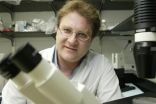Brain's involvement in processing depends on language's graphic symbols
Division of labor between the 2 sides of the brain during the reading of different languages: Brain processing involvement in the decoding of Arabic was different to the involvement in reading English; makes learning Arabic more challenging
2012-03-22
(Press-News.org) Readers whose mother tongue is Arabic have more challenges reading in Arabic than native Hebrew or English speakers have reading their native languages, because the two halves of the brain divide the labor differently when the brain processes Arabic than when it processes Hebrew or English. That is the result of a new study conducted by two University of Haifa researchers, Dr. Raphiq Ibrahim of the Edmond J. Safra Brain Research Center for the Study of Learning Disabilities and the Learning Disabilities Department, and Prof. Zohar Eviatar of the Department of Psychology.
"It emerges that the contribution of the two halves of the brain to processing written language depends on the graphic and linguistic structure of these languages," noted Dr. Ibrahim.
The two halves of the brain, called hemispheres, govern different types of activities: The right hemisphere specializes more in processing spatial tasks and the holistic (pattern) processing of messages, while the left hemisphere is responsible for processing verbal messages and local processing of messages.
In order to examine the interaction between the two hemispheres while reading Hebrew, English and Arabic, two experiments were conducted with subjects divided into three groups: those with Arabic as their mother tongue, those with English as their mother tongue and those with Hebrew as their mother tongue. Each group was tested in their native language.
In the first experiment, words and pseudowords (strings of letters that have no literal meaning) were presented on a screen, and the subjects were asked to figure out whether the stimulus was a real word; their response time, accuracy, and sensitivity were measured with every key pressed.
In the second experiment, the subjects were presented with various words on the right or the left side of the screen, which directs the information to be processed by the opposite hemisphere (i.e., when the proper or nonsense word is screened on the right side of the screen, it will be processed by the left side of the brain, and vice versa, a stage called "unilateral"). The various words were then shown on both sides of the screen, while under the target word there was a symbol that indicated that this was the word that they should treat, while the other stimulus appeared on the other side of the screen in order to distract the brain processing (this stage is called "bilateral").
A comparison of both experiments establishes the degree of interaction between the two hemispheres during the brain's processing of the language being checked.
The results show that for readers of Hebrew and English, both hemispheres of the brain are independently involved in the task of reading, such that neither side is dependent on the other. By contrast, for the Arabic readers, it emerged that the right hemisphere was not able to function independently in the reading assignments without using the resources of the left hemisphere.
According to Dr. Ibrahim, the significance of the findings is that despite the similarities between Arabic and Hebrew, when reading the former the right brain can't function independently and the cognitive burden becomes especially heavy, making it more difficult to read the language, even for those whose mother tongue is Arabic.
"This proves that the Arabic language doesn't behave like other languages when it comes to anything connected with decoding its graphic symbols," said Dr. Ibrahim.
"The study's results show once again that on the word reading level the structural shape of Arabic orthography, that is, the graphic contours of the written language, activates the cognitive system differently. Thus, the question is again raised as to whether in the modern world those who speak certain languages have an advantage over those who speak other languages; and the role of pedagogy in improving reading skills among regular readers and those having difficulty is brought once again to the fore."
INFORMATION:
To view the research paper, click on the link:
http://www.behavioralandbrainfunctions.com/content/8/1/3/abstract
For more information:
Rachel Feldman
Office: +972-4-8288722
Mobile: +972-54-3933092
Communications and Media Relations
University of Haifa, Israel
rfeldman@univ.haifa.ac.il
END
ELSE PRESS RELEASES FROM THIS DATE:
2012-03-22
Researchers at the Public University of Navarre (UPNA) are working on a project to design and manufacture composite PVC materials based on nanofillings and intended for multi-sectoral applications. The ultimate aim of the Vinilclay project is to control and optimize the properties of the plastic material; specifically, its photostability, thermal resistance and gas permeation.
The company Compuestos y Granzas, S. A. (CYGSA), which is acting as the co-ordinator, and the L'Urederra R+D Centre are also involved in the project. The researchers from the Public University of ...
2012-03-22
Founded in 1986, SThree is a world leader in the recruitment industry, with over 61 offices located in 18 Countries worldwide. SThree provides both permanent and contract staffing services across the ICT, Engineering & Energy, Pharmaceuticals & Biotechnology, Banking and Accountancy & Finance sectors.
Announcement of the new partnership was made at the start of March by SThree Director of Commercial Process, Andy Hallett, who commented "All companies chosen to appear in the PSL are the best in class and members of APSCo - the Association of Professional ...
2012-03-22
Powerful new cells created by Cardiff University scientists from cheek lining tissue could offer the answer to disorders of the immune system.
While the body's immune system protects against many diseases, it can also be harmful. Using white blood cells (lymphocytes), the system can attack insulin-producing cells, causing diabetes, or cause the body to reject transplanted organs.
A team from Cardiff's School of Dentistry led by Professor Phil Stephens, with colleagues from Stockholm's Karolinska Institute, have found a new group of cells with a powerful ability to suppress ...
2012-03-22
A group of biologists from Denmark and the US led by Jakob Christensen-Dalsgaard, University of Southern Denmark, and Catherine Carr, University of Maryland, have shown that the turtle ear is specialized for underwater hearing. The new discovery is published in Proceedings of the Royal Society B March 21st , Special features of the turtle ear – a large, air-filled middle ear and a movable tympanic disk increase its sensitivity for underwater sound. Laser measurements of disk vibrations in response to underwater sound show up to 100-fold larger vibrations of the disk than ...
2012-03-22
The behaviour of some of the most elusive particles in the known universe can be simulated using three atoms in a lab, researchers at the Centre for Quantum Technologies (CQT) at the National University of Singapore have found.
Principal Investigator Dimitris G. Angelakis and his group members Changsuk Noh and Blas Rodriguez-Lara have devised a scheme that uses the quantum states of three charged ions to simulate the 'oscillations' of neutrinos. The proposal is published in the March issue of New Journal of Physics.
Neutrinos are pesky things to study: they barely interact ...
2012-03-22
A recent study conducted at Marshall University may eventually help scientists develop new treatments for prostate cancer, the most common malignancy in American men.
The study, which focused on the effects of cadmium on the prostate, was conducted by Dr. Pier Paolo Claudio, an associate professor in the Biomedical Sciences Graduate Program and Department of Biochemistry and Microbiology at the university's Joan C. Edwards School of Medicine, and an international team of colleagues from the University of L'Aquila and the National Cancer Institute in Italy, and the University ...
2012-03-22
Tampa, Fla., USA – On March 22, during the 41st Annual Meeting & Exhibition of the American Association for Dental Research (AADR), held in conjunction with the 36th Annual Meeting of the Canadian Association for Dental Research, a symposium titled "Rewarding Educational Research: the Scholarship of Teaching and Learning" will take place to assist dental administrators, educators and members of appointment, promotion and tenure committees in understanding the role and potential of educational research and develop strategies to facilitate scholarly inquiry into student learning ...
2012-03-22
Tampa, Fla., USA – On March 22, during the 41st Annual Meeting & Exhibition of the American Association for Dental Research (AADR), held in conjunction with the 36th Annual Meeting of the Canadian Association for Dental Research, a symposium titled "Challenges in Salivary Diagnostics" will take place to discuss the issues with saliva collection and storage, proteomic analyses, and the growing interest and availability of commercial tests for salivary biomarkers.
Recently there has been a striking increase in published studies using salivary proteins and other oral biomarkers ...
2012-03-22
ControlManager offers people and organizations different advantages and it's a module based product. Some of these modules include a security handbook, risk management, creating emergency and contingency plans. This way, managers can quickly stop and continue working on different tasks and keep track of their progress at the same time.
Let's talk about some of the modules that come with ControlManager .
1. Risk Management - This module includes features like "View of Risk" and "Risk Assessment" that can help any IT manager make their job easier. ...
2012-03-22
Tampa, Fla., USA – On March 23, during the 41st Annual Meeting & Exhibition of the American Association for Dental Research (AADR), held in conjunction with the 36th Annual Meeting of the Canadian Association for Dental Research, a symposium titled "TMJ: Stem Cell Biology and Engineering toward Clinical Translation" will provide a rare forum for multidisciplinary discussion of the biology, engineering and clinical translation of fundamental discoveries towards novel clinical therapy. The symposium is co-sponsored by the Craniofacial Biology, Mineralized Tissue and Neuroscience ...
LAST 30 PRESS RELEASES:
[Press-News.org] Brain's involvement in processing depends on language's graphic symbols
Division of labor between the 2 sides of the brain during the reading of different languages: Brain processing involvement in the decoding of Arabic was different to the involvement in reading English; makes learning Arabic more challenging

